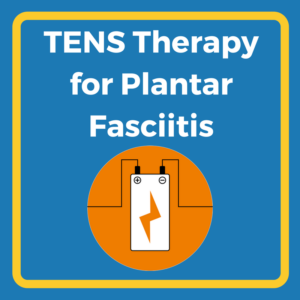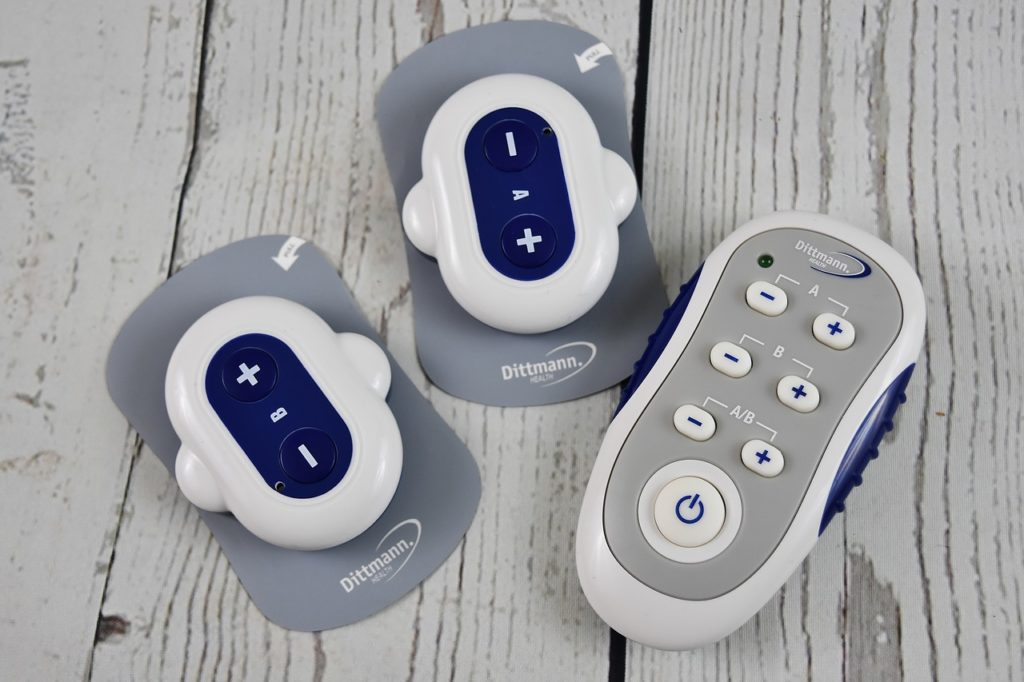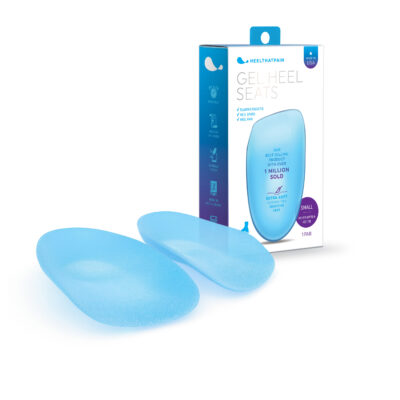 TENS therapy, which stands for “Transcutaneous Electrical Nerve Stimulation,” uses a low-frequency electrical current to stimulate the plantar fascia, with the goal of improving blood flow and blocking the body’s pain signals.
TENS therapy, which stands for “Transcutaneous Electrical Nerve Stimulation,” uses a low-frequency electrical current to stimulate the plantar fascia, with the goal of improving blood flow and blocking the body’s pain signals.
While this therapy is more costly than other more conservative, noninvasive methods for treating plantar fasciitis at home (simplified options are closer to $50, while higher-end products fall in the neighborhood of $250), some of the cost may be covered by your insurance! TENS therapy is also far less expensive and risky than surgery or other medical interventions.
Here’s what you should know about TENS therapy before you give it a try for foot pain!
TENS Therapy and Foot Pain
TENS therapy works by attaching electrodes to the feet (and sometimes calves) that deliver very small pulses of electrical current. This current causes the muscles in the feet and legs to contract and release at intervals, which is designed to improve blood flow as well as interrupt the body’s signals for pain. You’ll feel a gentle pulsing sensation, as well as some vibration in the soles of your feet while the device is working. Some TENS devices look like a pair of sandals that you slip onto your feet, others look like a cell phone with electrodes attached, while still others look like a small platform that you place your feet.

There’s a lot of anecdotal evidence that TENS therapy helps reduce inflammation, reduces stiffness and pain to the plantar fascia, and reduces pain while walking and other physical activity. However, it’s important to understand that TENS therapy is not intended to be a cure for plantar fasciitis–but rather a pain-reduction method.
Does TENS Therapy Work?
The number one question on everyone’s mind is, of course, does TENS therapy work? While the answer isn’t as conclusive as you might like, there’s still good news: One major study, which separated plantar fasciitis sufferers into two groups (one that only used stretching and orthotics, and one that used stretching, orthotics, and low-frequency electrical stimulation therapy) found that both groups reported significantly less morning pain and overall symptoms of plantar fasciitis. In other words, if you want to give TENS therapy a try, you can feel confident that, as long as you combine this therapy with tried and true treatments like orthoses and stretching, you’ll be setting yourself up for success.
Many companies offer a money-back guarantee, so you can try before you fully commit to the investment of TENS therapy. Make sure to read the warranty and guarantee information carefully before purchasing.
TENS vs ESWT
While TENS therapy and ESWT therapy (extracorporeal shock wave therapy) might seem similar, since they both use electrical currents, the two procedures are different in several ways. ESWT is far more expensive (nearly $1000 before insurance in many cases), and must be done by a licensed professional in a doctor’s office. It’s also more painful, and can cause intense discomfort, redness, and swelling.
Like TENS therapy, ESWT hasn’t been proven, and studies of its effectiveness are limited and mixed. For many people TENS therapy is a cost-effective, at-home way of experimenting with the results of electrical current on their plantar fasciitis.
Is TENS Therapy Safe?
TENS therapy can be done at home with a portable unit, has minimal risks, and is considered very safe. As with all forms of muscle work, make sure to keep yourself hydrated while using TENS therapy, to avoid fatigue and any buildup of toxins that may be released during muscle stimulation.
It’s also important to pace yourself while using TENS therapy. Some people have reported muscle tightness and discomfort after prolonged periods of use, or if the setting is too high. Work up to longer sessions gradually, and avoid using TENS therapy for long periods of time.
Since TENS therapy uses electrical current, you shouldn’t use it if you have a pacemaker. If you’re pregnant or have other medical complications, make sure to consult your doctor before starting TENS therapy.
Whether you choose to give TENS therapy a try, or not, remember that 90% of plantar fasciitis cases can be resolved with a little time and consistent, conservative treatment. Along with any pain-reduction methods you try, make sure to use tried and true orthotics for plantar fasciitis, stretching, and icing to address the root cause of your foot pain. Here’s to the health of your feet!




So where can I buy this TENS unit?
Hi Kathleen
You can find TENS units on Amazon or other purchasing sites, or you can ask or physical therapist or doctor which unit they recommend. Hope this helps 🙂
Where on your foot did you place the pads?
I bought mine at Rite Aide , our local pharmacy for $39 . I got the pad that is supposed to be used on a lower back . and it fit over my arch perfectly and it helped a lot .
I got mine on Amazon for a bit less than $30. There are tons of different kinds out there so do your research in what you’re looking for & of course, product review. I love having this handy for those late night aches that keep me awake.
I have been told by my GP that I have plantar fasciitis although the pain is not in my heel but runs along the length of the plantar tendon and is mainly felt in the arch. I already own a tens machine but am unsure of where to position the pads. Any ideas?
Hi Sally! Your doctor or physical therapist would be the best one to help you with the positioning of your TENS pads. This site has a cool graphic around halfway down the page that shows positions on the ankle and foot that may help with PF pain: http://www.painawaydevices.com/basic-guide-for-tens-unit/#6_Using_the_TENS_for_Lower_Back_Pain
I have plantar fasciitis as well and I have one pad on my heel and one on the inside of my heel. Working well
Just started using Tens 2 days ago. Vicki how are you feeling?
I bought mine from OTC Wholesale. for $33.97 that included the shipping. Its a Drive model AGF 3-E
Where do you place the electrodes? I have the same unit in the picture. I have been placing one on the bottom of my foot and the other above my ankle. Is there better placement?
i have a nhs tens unit with the 2 electrodes pads : but im not sure where to place them on the foot for heel pain can you help/advice on where to place the 2 pads ?
I just recently had a MRI of my left foot. It showed fluid and my planters fascia is very thick. I guess it should be thin. I’m now starting to get pain in my right foot. Which device would work best for me ? I also have been experiencing calf pain too.
I have an intensity 10 unit and the nice thing about it is that it actually has a preset program for the foot.
I’d go to a podiatrist. You have to stretch your calf muscles a lot in addition to the PF stretches. Google calf stretch exercises. The one where you stand against a wall and put your noninjired foot in front and injured behind, keeping injured/back leg straight while leaning forward works best for me. Several times a day. Your podiatrist will prob give you this boot thing that you can use to do actual PF stretches. There are also stretches you can do with a resistance band which I’m currently doing in physical therapy but it’s trickier than the boot. Also ice it every night. Don’t be stupid like me and let it build for 3 years and need surgery.
Hi. Do you have any info on the placements of the electrode pads. My unit has pads that are approx 50mm discs. Or would it be better to get smaller pads
I had plantar fascia surgery plus a bone spur removed 10 + Weeks ago. Will this help with the pain?
Hi,
Would this also work for heel spur in the foot?
Where is is available?
Hi Florence, a lot of people do experience pain relief from this method for heel spurs and related pain. You can get a portable TENS unit on Amazon or at your local drugstore.
Is this similar to the electrode treatments I’m getting from my physical therapist? I have a ripped plantar fascia along with 3 spurs on each heal and the hellacious pain that goes with it. I’ve worn the air cast boot for 8 weeks, had the steroid injections, taken duexis for 3 months, as well as done the stretch exercises. My physical therapist has been treating my pain and inflammation with ultrasound and electrode therapy for 2 weeks, but nothing is helping.